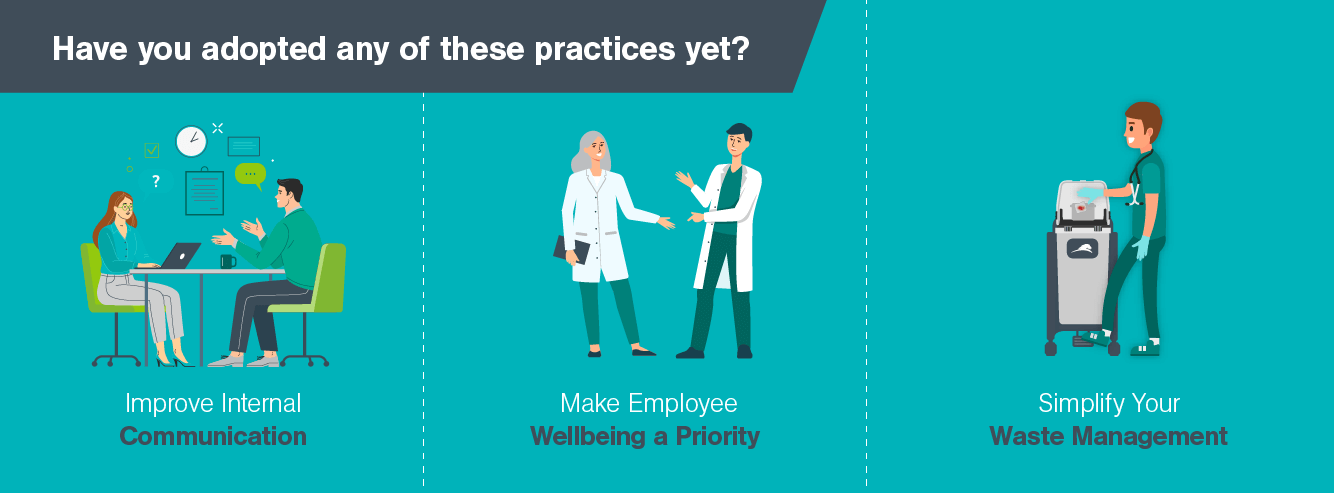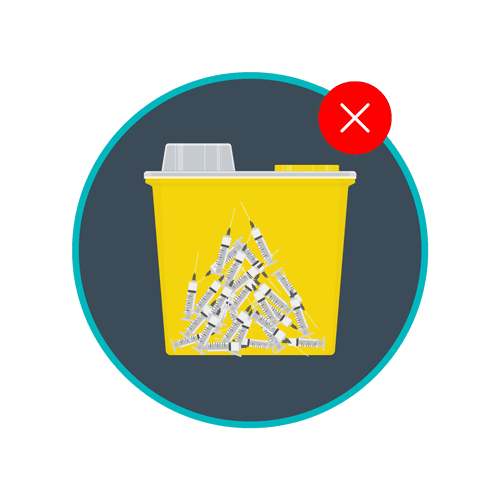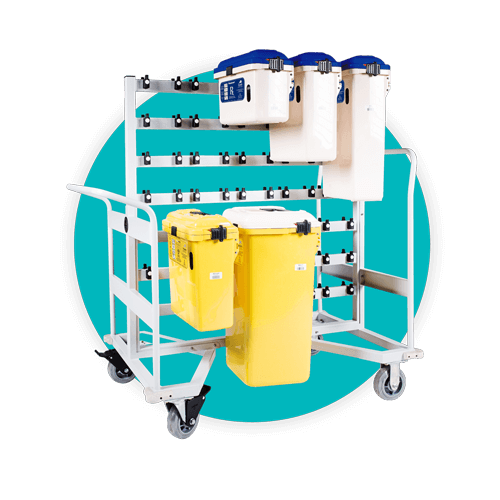Strategies to Improve Efficiency and avoid Burnout at Your Healthcare Facility

Healthcare facilities today have to deal with a lot, from rapidly increasing patient numbers to short staffing, all while achieving the same mission of saving lives. These challenges not only threaten to reduce the quality of care that facilities offer to their patients but also result in a lot of burnout for front-line workers.
As a result, more than ever before, healthcare facilities face the need to improve efficiency. Doing this will not only help to deal with increasing workloads but also reduce stress on critical staff members. Here are a few tips to help improve efficiency without reducing the quality of healthcare at facilities.
TOPICS WE WILL COVER:
1 / Improve Internal Communication
2 / Make Employee Wellbeing a Priority
3 / Utilize the Latest Technology
4 / Simplify Your Waste Management
Improve Internal Communication
As with any organization, effective communication is the key to success for every healthcare facility. Many studies have reaffirmed that internal communication is linked to productivity. Effective communication starts with making sure that everyone is made aware of critical information, news, and developments within the organization.
Further, communication between different departments and specialists is key to avoiding errors and ensuring effective collaboration. Making sure that every team member is kept abreast of organizational developments and working in coordination can increase productivity and morale while helping to reduce burnout.
Taking this step may involve investing in new workplace communications platforms to enable easier cross-team and cross-department messaging. Or perhaps, your facility could establish clearer guidelines for exactly what needs to be communicated to whom. It’s important not to go too far and waste precious time with excessive meetings or unneeded messages. However, clearer, more frequent internal communication is almost always a boon to healthcare organizations.
Make Employee Wellbeing a Priority
In healthcare, patient wellbeing is naturally the focus of most conversations. But, what should be equally as important is how employees are being cared for. Front-line healthcare workers are responsible for caring for patients and generating results. However, more often than not, their wellbeing is of secondary concern.
This invariably leads to reduced productivity and a high risk of burnout. In fact, in its 2021 National Physician Health Survey, the Canadian Medical Association found that more than one in two physicians and residents suffered from burnout.
The fact is that a well-rested employee with a positive attitude will be able to better approach the tasks at hand, manage their workflow, and provide better quality work. This means that prioritising employee wellbeing is an essential facet of improving efficiency in any healthcare facility.
This being the case, activities such as providing mental and physical health services for employees and wellness programs are not just an investment in employees’ wellbeing. They are also an investment in organizational efficiency. Though short-term benefits may be small, in the long term, investing in employee wellness will always pay off.
Utilize the Latest Technology
Keeping ahead of the curve and utilizing the best available technology should be the goal of any healthcare organization looking to improve efficiency. However, that does not mean utilizing all available technology all the time. Too much technology and too many platforms to keep track of can be a source of burnout and inefficiency. The wise choice is to focus on implementing those technologies that can make the biggest and smartest changes to workflows.
A common source of inefficiency is forcing employees to use tech tools that are nonessential and un-useful to their jobs. Some healthcare organizations have attempted to take HR management tools and run those as a healthcare management system. Yet, these tools are not designed for such a purpose and pose significant drawbacks for users. Employees find themselves restricted in their processes and unable to complete tasks in the way they’d like. Thoughtless technology adoption should be avoided in favour of selecting solutions that actually work for the teams using them.
Owing to the COVID-19 epidemic, many healthcare facilities have greatly expanded their usage of remote work technologies. Platforms that enable employees to conduct work from outside the facility are now a necessary part of workflows. They are crucial for allowing employers to retain a remote workforce to combat short-staffing. These digital platforms can also help with adapting to patients who may need remote accommodations due to medical conditions. Adopting remote work solutions to solve the needs of the organization is a great way to improve efficiency and improve workplace morale.
Integrate Electronic Tools
Many employers are investigating the possibilities for AI (artificial intelligence) in the healthcare industry. Although many questions remain about the feasible implementation and ethics of these programs, early adopters see great potential in AI. Managers believe AI’s ability to cut out monotonous, stressful, and burnout-inducing tasks free employees to focus on more meaningful work.
Systems for visitor and electronic medication management are perfect areas to begin looking into automation options. Thoughtful automation can alleviate stresses on staff, grow productivity, enable better performance, and help them stay motivated in fast-moving environments.
Concentrate on Improving the Efficiency of Workflow Management
Managing workflow means more than just assigning workers to their roles and then creating a schedule. Healthcare facility managers frequently have to manage a large variety of services which means dealing with complicated differences and changes in workflow between these services. Unfortunately, this can easily result in inefficiencies in these workflows. But there are ways to improve this situation.
One way to improve efficiency is to always consider the experience and knowledge workers have when assigning tasks. This step should be taken as soon as you hire a worker. A manager should evaluate their skills and then assign them to a job that will require a minimum of training. For workers that are skilled in several areas, managers could consider allowing the employee to fill more than one role to improve the facility’s productivity.
This procedure can also be applied to existing workers. Managers could examine the skills of current workers and ensure they are assigned the job that best matches their skills. Then, any workers with skills that are better suited to a different job could be reassigned. This will not only ensure that the facility has the best person assigned to a job—it will also let workers see that their skills and talents are appreciated. Additionally, workers will gain more knowledge and experience in the areas in which they have expertise.
Simplify Your Waste Management
If there is one thing that every healthcare facility must deal with, it is waste. Sharps, surgical waste, chemotherapy waste, and more present classification and disposal challenges that take a considerable number of labour hours for staff to deal with.
These wastes must be managed effectively in order to ensure the safety of their staff, patients, and the public, as well as the environment, which could otherwise be exposed to the kinds of hazardous wastes that healthcare facilities must deal with on a regular basis. To effectively handle these types of waste, healthcare facilities must develop an efficient system for handling the waste. Unfortunately, however, many healthcare facilities have inefficient, outdated waste management processes. These practices often lead to unnecessary labour and waste, which can negatively affect patients and staff.
Many facilities still use traditional medical waste disposal practices, which involve using several containers, such as single-use containers that require frequent disposal and replacement, as well as bags that can be hazardous to those using them. These types of waste management solutions waste time that could be better spent caring for patients and expose staff to unnecessary dangers and stress.
Upgrade Your Waste Management
Healthcare facilities can streamline workflow and lower the risk of exposure by investing in a state-of-the-art waste management system. An innovative system like the one Daniels employs helps to improve the safety and efficiency of a facility’s waste management process. Daniels can provide intelligently-designed, reusable containers that do not require bags. This range of containers also offer mounting accessories that permit them to be easily moved from walls to carts. This allows medical waste to be more safely and efficiently collected, transported throughout the hospital and stored.
Daniels even has bulk storage units that are made to fit a standard-sized corridor. These containers use minimal space while handling bulk waste collection in small areas. Our containers allow workers to load several units onto one cart without having to deal with any bags or complicated disposal mechanisms. This makes for a far more efficient disposal system that requires less labour and time while increasing safety.
Improving efficiency in your healthcare facility is key to providing the best possible care for patients and ensuring the staff’s well-being. Focusing on the strategies above can help to make your organization run more smoothly. It can also help prevent the staff burnout that many facilities have struggled with.
Let's Talk!
Your time is valuable, and we don’t want to play hard to get. You can either phone us directly on the details listed on our contact page, or feel free to fill out this short form and one of our team members will get back to you as quickly as possible.
